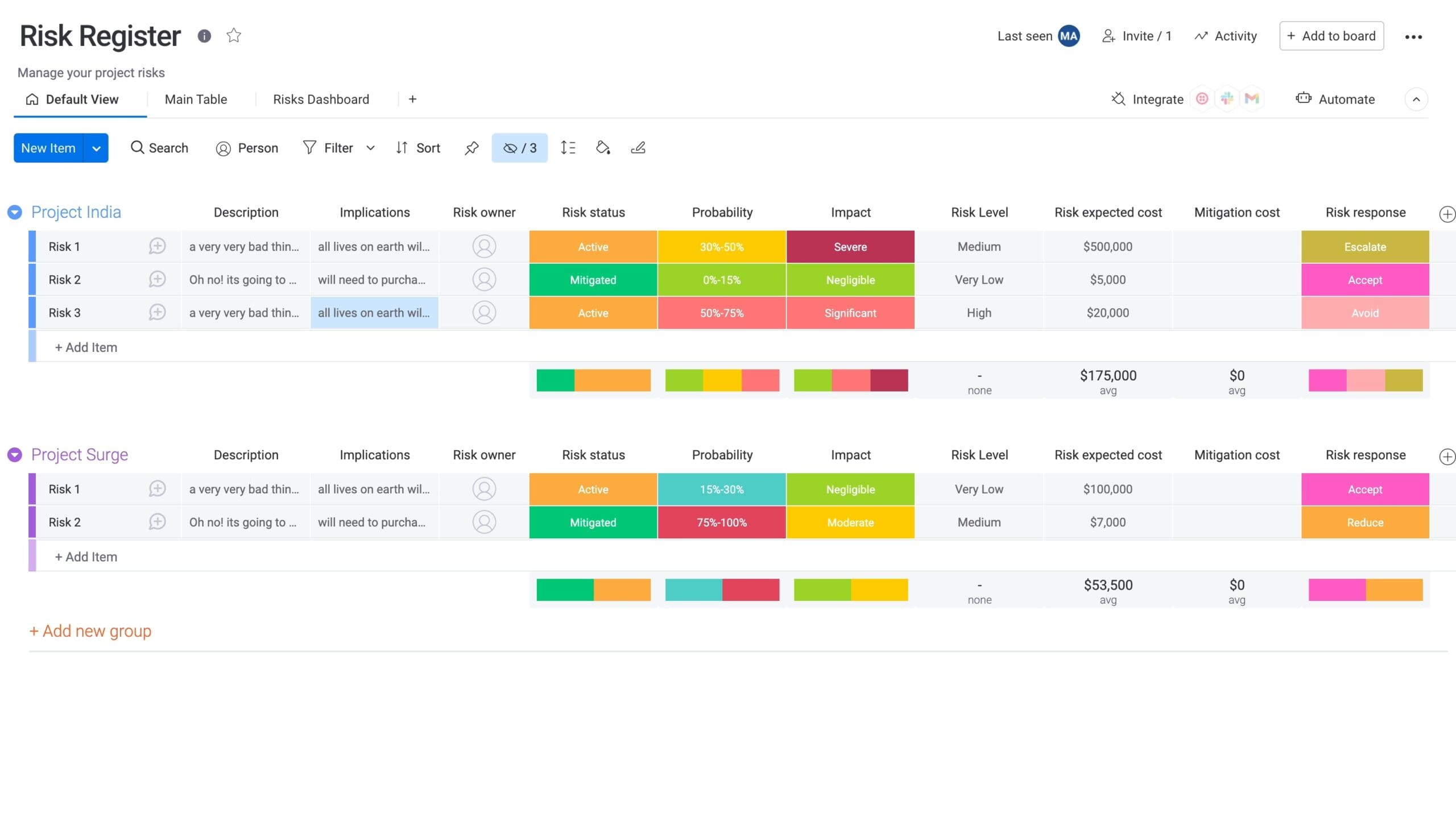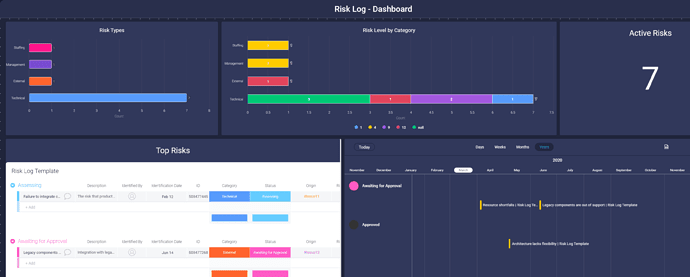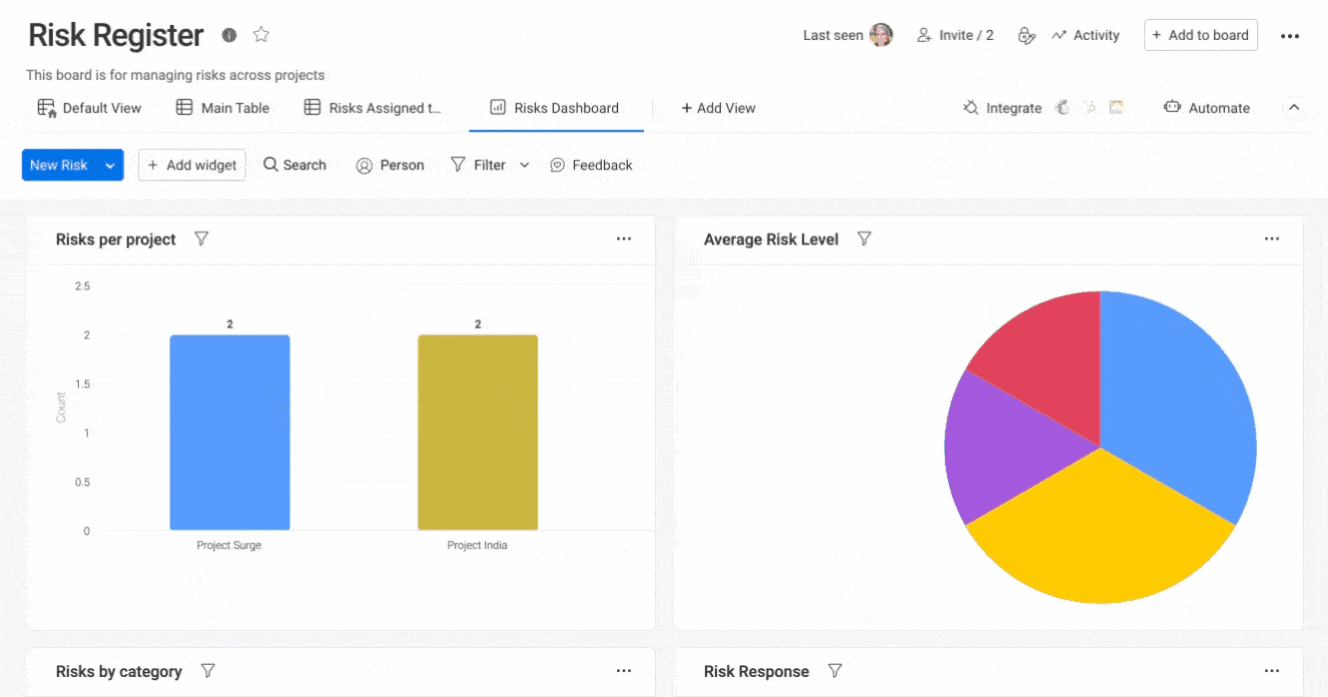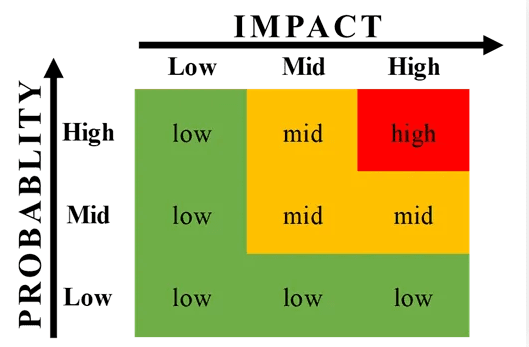Every project involves some degree of uncertainty — shifting priorities, resource constraints, or external factors that can change outcomes overnight. The difference between chaos and control often comes down to how consistently teams identify, assess, and respond to risk.
Risk management templates provide the foundation for that consistency. They transform risk handling from a reactive process into a structured system that tracks potential threats, assigns ownership, and ensures accountability across teams. Used well, they turn uncertainty into actionable insight and strengthen decision-making across every project.
In this post, you’ll find essential templates that guide every stage of risk management — from planning and identification to mitigation and reporting — along with practical ways to connect them into one cohesive, real-time workflow.
Key takeaways
- Begin with a risk register: document all potential threats, then apply a risk assessment matrix to prioritize them by probability and impact.
- Apply structured response strategies: use the four core approaches — avoid, mitigate, transfer, or accept — to create actionable plans with clear ownership and timelines.
- Enhance visibility with monday work management: centralize your templates into a dynamic system featuring real-time updates, automated alerts, and visual dashboards.
- Tailor templates to your needs: adapt frameworks by industry and company size, focusing on operational, financial, strategic, and compliance risks.
- Review and update regularly: assess critical risks weekly and moderate risks monthly to keep your risk management system current and effective.
What are risk management templates?
Risk management templates are pre-built documents that help you identify, assess, and control risks across your organization. Essentially they act as blueprints that guide your team through evaluating threats — from cybersecurity breaches to supply chain disruptions — using the same proven risk management process every time.
These templates transform risk management from guesswork into a repeatable system. Instead of starting from scratch, you follow structured frameworks that drive consistent decision-making, which research shows leads to improved business outcomes and faster revenue growth.
Before diving into specific templates, let’s define the key terms you’ll encounter in this guide:
- Risk identification: finding and documenting potential threats before they impact your business.
- Risk assessment: measuring how likely risks are to occur and how much damage they could cause.
- Risk mitigation: creating action plans to reduce or eliminate risk exposure.
- Risk monitoring: Tracking risks over time to ensure your responses stay effective.
Top 7 risk management templates for effective risk control
Different situations call for different templates. Each one listed below serves a specific purpose in building a comprehensive enterprise risk management system that protects your operations while supporting growth.
Risk management plan template
Your risk management plan template is the master document that defines how your organization approaches risk. It sets the ground rules — who’s responsible for what, how often you’ll review risks, and what happens when threats materialize.
This template includes your risk tolerance levels, escalation procedures, and communication protocols. It also maps out which departments handle specific risk types and how decisions flow through your organization.
Risk register template
A risk register template creates your central risk database. This living document supports risk tracking with details like description, probability, impact, owner, and current status.
By utilizing a platform like monday work management you can turn static risk registers into dynamic systems. Real-time updates, automated notifications, and visual dashboards (which are features of the platform) make risk information instantly accessible to everyone who needs it.
Risk assessment matrix template
A risk matrix helps you visualize and prioritize threats based on probability and impact. Most use a simple grid — probability on one axis, impact on the other — creating risk scores from low to critical.
Color coding makes priorities obvious. Red means immediate action needed, yellow indicates monitoring required, and green shows acceptable risks. This visual approach speeds up decision-making across all levels.
Risk mitigation plan template
This template converts identified risks into concrete action plans. Each risk gets linked to specific strategies, responsible parties, and completion deadlines.
Your risk mitigation plan should track both preventive measures and contingency responses. It also monitors the cost and effectiveness of each action, helping you optimize risk management investments over time.
Similarly, performing an impact analysis helps measure the outcomes of each response, while having a contingency plan ensures you’re ready if unexpected changes occur.
Issue and action tracking template
When risks become real problems, understanding risk vs issue helps you apply this template effectively. It provides structure for incident handling, resolution tracking, and capturing lessons learned.
Key elements include severity classifications, response team assignments, and post-incident analysis. This ensures quick, coordinated responses when risks materialize.
Project risk dashboard template
Dashboard templates aggregate risk data from multiple projects into executive-ready views. Leaders see portfolio-wide risk exposure, trending issues, and mitigation progress at a glance. In worst-case scenarios, a disaster recovery plan template provides defined steps to restore critical operations.
Work management platforms like monday work management provide dashboards that can pull live data from all your projects, creating real-time visibility without manual report building.
Risk communication template
Different stakeholders need different levels of risk information: this template provides frameworks for tailoring risk reports — detailed risk analysis for project teams, high-level summaries for executives.
It includes communication frequency guidelines, escalation triggers, and audience-specific formatting to ensure everyone gets the information they need.
Try monday work management
How to create a risk management plan template
Building an effective risk management plan starts with understanding your organization’s unique needs. Your template should be comprehensive enough to capture critical information yet simple enough for consistent use.
Follow the guidance below and you’ll be well on your way to creating a successful template.
Essential elements of your risk plan
Your risk management plan needs several core components working together. Start with specific objectives — what are you trying to protect? Revenue? Reputation? Operational continuity?
Next, define your risk categories to organize threats logically:
- Operational risks: process failures, system outages, and human errors.
- Financial risks: budget overruns, market changes, and credit exposure.
- Strategic risks: competitive threats, technology shifts, and market disruption.
- Compliance risks: regulatory changes, legal issues, and policy violations.
Be sure to include your risk assessment methodology too — the specific criteria teams will use to evaluate risks consistently. Define probability scales, impact measurements, and how you’ll calculate overall risk scores.
Roles and responsibilities prevent gaps in coverage, which is critical when 92% of senior leaders believe their organization fosters shared ownership, but only 76% of individual contributors agree.
Remember, it’s vital to specify who identifies risks, who assesses them, who develops responses, and who monitors progress.
Customizing for your organization
Your industry shapes your risk profile. Healthcare organizations focus on patient safety and HIPAA compliance. On the other hand, technology companies prioritize data security and rapid market changes, while manufacturing emphasizes operational continuity and supply chain stability.
Company size matters too. Smaller organizations need streamlined templates with fewer approval layers. Large enterprises require sophisticated governance structures and detailed documentation, especially since only 61% of their employees are satisfied with organizational transparency.
Building an effective risk register template
A well-structured risk register centralizes all your threat information in one accessible location.
Let’s explore the essential components that transform a simple spreadsheet into a powerful risk management tool.
Key fields to include
Essential fields capture both descriptive and actionable information about each risk. Start with risk identification basics — a unique ID, detailed description, category, and potential causes.
- Probability rating: how likely is this risk to occur?
- Impact assessment: what damage would it cause?
- Risk score: combined probability and impact rating.
- Detection difficulty: wow hard is it to spot early warning signs?
Management fields ensure accountability:
- Risk owner: who’s responsible for monitoring and response?
- Current status: open, in progress, monitoring, or closed.
- Mitigation actions: specific steps to reduce the risk.
- Target dates: when actions should be complete.
Tracking risk status and updates
Regular updates keep your risk register relevant. Use standardized status categories everyone understands — “Open” for new risks, “In Progress” for active mitigation, “Monitoring” for controlled risks, and “Closed” for resolved threats.
Schedule review cycles based on risk severity. Critical risks might need weekly reviews, while low-priority items can be checked monthly.
By using work management platforms such as monday work management, you can automate the entire review process. Schedule recurring reminders, escalate overdue actions, and track updates over time — all without manual follow-up.

Risk assessment matrix templates that work
Visualizing risk priority is essential for making informed decisions about where to focus your resources.
These matrix templates below provide the structure you need to consistently evaluate threats and communicate their severity across your organization.
Setting up probability and impact scales
Define specific criteria for each scale level. Instead of vague terms like “low” or “high,” use specific thresholds teams can evaluate objectively.
- Level 1 (Rare): less than 10% chance in the next year.
- Level 2 (Unlikely): 10–30% chance in the next year.
- Level 3 (Possible): 30–50% chance in the next year.
- Level 4 (Likely): 50–80% chance in the next year.
- Level 5 (Almost certain): more than 80% chance in the next year.
Impact scales should reflect what matters most to your business — financial loss, operational disruption, regulatory penalties, or reputation damage.
Color-coding for quick risk identification
Visual indicators make matrices actionable. The traffic light system works universally — red for critical risks, yellow for moderate concerns, green for acceptable levels.
Again, monday work management’s visual boards naturally support this approach. Customize colors to match your risk tolerance and see portfolio-wide risk status instantly.
Try monday work managementDeveloping risk mitigation plan templates
Once you’ve identified and assessed your risks, you need structured plans to address them. Effective risk mitigation templates transform abstract threats into concrete action steps with clear ownership and timelines.
4 core risk response strategies
Risk theory identifies four fundamental approaches. Your template helps teams choose the right strategy based on cost, feasibility, and organizational priorities:
- Avoid: eliminate the risk by changing plans or processes.
- Mitigate: reduce probability or impact through preventive controls.
- Transfer: shift risk to insurance, vendors, or partners.
- Accept: monitor risks within your tolerance levels.
Linking risks to actionable tasks
Turn high-level mitigation strategies into clear, trackable actions with defined owners, deadlines, and success criteria.
With monday work management, these actions become part of an integrated workflow where automated reminders maintain momentum and real-time updates show progress against each mitigation plan.

Risk dashboard templates for real-time monitoring
Visibility is the foundation of proactive risk management. As projects evolve, you need more than static reports — you need live insight into where risks are emerging, how mitigation efforts are progressing, and which areas demand attention.
Below, we’ll look at the key metrics your dashboards should display and how to tailor reporting for both operational teams and executive stakeholders.
Critical risk metrics to display
Your dashboard should balance current status with trend analysis. Include metrics that drive action:
- Risk distribution: number of risks by category and severity.
- Mitigation progress: percentage of actions completed on time.
- Emerging threats: new risks identified this period.
- Risk velocity: how quickly risks are escalating or improving.
Creating executive-ready reports
Executive dashboards should emphasize what drives decisions — key trends, exceptions, and strategic impacts — rather than every detail.
With platforms like monday work management, you can generate tailored views from a single source of data. Executives get concise, high-level insights, while teams access detailed updates in real time to keep actions aligned with strategy.
How to choose the right risk management framework template
Not all risk management templates are created equal: your industry, company size, and specific threats require thoughtful customization.
The right framework transforms theoretical risk management into practical protection tailored to your organization’s unique challenges.
Industry-specific template considerations
Different sectors face unique challenges requiring specialized approaches:
- Technology: focus on cybersecurity, data privacy, and market disruption. According to PwC, cybersecurity is the number one business risk on managers’ minds, with 78% worried about more frequent or broader cyber attacks.
- Healthcare: emphasize patient safety, HIPAA compliance, and clinical risks.
- Manufacturing: priority on operational continuity, safety, and supply chain.
- Financial services: concentrate on credit risk, market volatility, and regulatory compliance.
Scaling templates across your organization
As organizations grow, risk management becomes more complex. Templates need to scale across departments and locations while keeping processes consistent and comparable.
Standardized criteria, language, and formats make it possible to consolidate insights at the organizational level — without losing flexibility. By adopting a platform like monday work management, teams can customize risk templates to fit their workflows while maintaining the structure needed for unified reporting and governance.

Transform risk management with monday work management
Managing risk effectively today requires more than static spreadsheets or disconnected reports. As projects evolve and new threats emerge, teams need adaptable systems that provide real-time visibility, automate oversight, and keep everyone aligned on priorities.
With monday work management, risk management becomes an integrated, continuous process — one that connects data, automates actions, and empowers teams to respond faster and more confidently. Below, explore how its key capabilities help turn risk management from a reactive task into a proactive strategy.
Automate risk monitoring and alerts
Manual monitoring misses critical changes. Automation ensures nothing falls through the cracks.
Set up custom triggers in monday work management to notify teams when risk scores exceed thresholds, reviews are overdue, or new threats emerge. These workflows reduce administrative burden while improving response times.
Build custom risk workflows
Every organization manages risk differently — and your workflows should reflect that. Instead of working around rigid templates, you can design processes tailored to your structure and priorities.
With monday work management, create custom workflows without writing a single line of code:
- Approval flows: Route risk assessments to the right stakeholders for review.
- Escalation paths: Automatically notify leaders when critical risks emerge.
- Review cycles: Schedule recurring evaluations to keep risk data current.
Connect risk data across teams
Risk management works best when integrated across your entire organization. Cross-functional visibility identifies systemic risks and coordinates responses.
The platform connects risk information from different teams into unified dashboards. Leadership gains comprehensive views while teams collaborate on shared threats — all with real-time data.
Leverage 200+ integrations
Your risk management doesn’t exist in isolation. Connect monday work management to your existing tech stack through 200+ native integrations with tools like Slack, Microsoft Teams, and Google Workspace.
Sync risk data with your CRM, pull information from financial systems, or connect to specialized compliance tools—all without manual data entry. These integrations create a seamless information flow that keeps risk data current and accessible exactly where your teams already work.
Enhance risk management with AI capabilities
AI-powered features transform how you identify and respond to risks. monday AI helps you draft risk descriptions, summarize complex threat assessments, and generate mitigation strategies based on historical patterns.
Natural language processing identifies potential risks in project communications, while predictive analytics spots emerging threat patterns before they become critical. These intelligent capabilities help teams stay ahead of risks rather than simply reacting to them.
Try monday work managementFrequently asked questions
What is the difference between a risk register and a risk assessment matrix?
The difference between a risk register and a risk assessment matrix is that a risk register is a comprehensive list documenting all identified risks, while a risk assessment matrix is a visual tool used to prioritize those risks based on probability and impact.
How often should risk management templates be updated?
Risk management templates should be reviewed quarterly for strategic risks and monthly for project-level risks, with high-priority or volatile risks requiring weekly or daily monitoring depending on their potential impact.
Can risk management templates work for small businesses?
Risk management templates work excellently for small businesses when simplified to focus on critical risks and streamlined to match available resources without creating administrative overhead.
Which risk management template should I start with?
Start with a basic risk register template to identify and document your key risks, then add a risk assessment matrix to prioritize them based on probability and impact.
How do you integrate risk templates with project management platforms?
Risk templates integrate with project management platforms by linking risk data to specific projects, enabling automated updates, and creating dashboards that display risk status alongside project progress.
What are the 5 stages of risk management?
The five stages of risk management are risk identification (finding potential threats), risk assessment (evaluating probability and impact), risk mitigation (developing response strategies), risk monitoring (tracking over time), and risk review (learning and improving the process).
 Get started
Get started 

